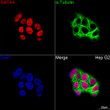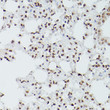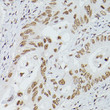| Host: | Rabbit |
| Applications: | WB/IHC-P/IF/ICC/ELISA |
| Reactivity: | Human/Mouse/Rat |
| Note: | STRICTLY FOR FURTHER SCIENTIFIC RESEARCH USE ONLY (RUO). MUST NOT TO BE USED IN DIAGNOSTIC OR THERAPEUTIC APPLICATIONS. |
| Clonality : | Polyclonal |
| Conjugation: | Unconjugated |
| Isotype: | IgG |
| Formulation: | PBS with 0.05% Proclin300, 50% Glycerol, pH 7.3. |
| Purification: | Affinity purification |
| Concentration: | Lot specific |
| Dilution Range: | WB:1:500-1:1000IHC-P:1:50-1:200IF/ICC:1:50-1:200ELISA:Recommended starting concentration is 1 Mu g/mL. Please optimize the concentration based on your specific assay requirements. |
| Storage Instruction: | Store at-20°C for up to 1 year from the date of receipt, and avoid repeat freeze-thaw cycles. |
| Gene Symbol: | GATA4 |
| Gene ID: | 2626 |
| Uniprot ID: | GATA4_HUMAN |
| Immunogen Region: | 350-442 |
| Specificity: | A synthetic peptide corresponding to a sequence within amino acids 341-440 of human GATA4 (NP_002043.2). |
| Immunogen Sequence: | PPASGASSNSSNATTSSSEE MRPIKTEPGLSSHYGHSSSV SQTFSVSAMSGHGPSIHPVL SALKLSPQGYASPVSQSPQT SSKQDSWNSLVLADSHGDII |
| Post Translational Modifications | Methylation at Lys-300 attenuates transcriptional activity. |
| Function | Transcriptional activator that binds to the consensus sequence 5'-AGATAG-3' and plays a key role in cardiac development and function. In cooperation with TBX5, it binds to cardiac super-enhancers and promotes cardiomyocyte gene expression, while it down-regulates endocardial and endothelial gene expression. Involved in bone morphogenetic protein (BMP)-mediated induction of cardiac-specific gene expression. Binds to BMP response element (BMPRE) DNA sequences within cardiac activating regions. Acts as a transcriptional activator of ANF in cooperation with NKX2-5. Promotes cardiac myocyte enlargement. Required during testicular development. May play a role in sphingolipid signaling by regulating the expression of sphingosine-1-phosphate degrading enzyme, sphingosine-1-phosphate lyase. |
| Protein Name | Transcription Factor Gata-4Gata-Binding Factor 4 |
| Database Links | Reactome: R-HSA-2032785Reactome: R-HSA-400511Reactome: R-HSA-5578768Reactome: R-HSA-9690406Reactome: R-HSA-9733709Reactome: R-HSA-9758920Reactome: R-HSA-9823730Reactome: R-HSA-983231 |
| Cellular Localisation | Nucleus |
| Alternative Antibody Names | Anti-Transcription Factor Gata-4 antibodyAnti-Gata-Binding Factor 4 antibodyAnti-GATA4 antibody |
Information sourced from Uniprot.org
















